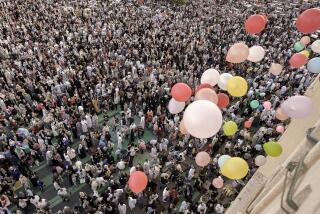Nouruz: Have a Happy Equinox
- Share via
Iranians believe that Nouruz, their New Year holiday, was instituted in the days of the legendary King Jamshid, and it certainly has been celebrated for at least 2,500 years. No wonder. For followers of the ancient Zoroastrian faith, it’s a religious festival; what’s more, for Zoroastrians--and Muslims--it’s as if our New Year’s, Christmas, Thanksgiving and spring cleaning all came at the same time.
With all the feasting and partying that goes along with Nouruz, it easily withstood the coming of Islam to Iran. In fact, during the Middle Ages, Persians spread the holiday throughout the Muslim world, much as New Englanders introduced other Americans to Thanksgiving. At one time, Nouruz was celebrated as far west as Moorish Spain, though today it’s once again celebrated primarily by Iranians and Indian Parsis.
The medieval version of the holiday lasted a week, during which there was a general carnival with bonfires, acrobats, jugglers, masked games, gift-giving and exchanges of candies and dyed eggs. Colleges were closed, and if a professor showed his face he would be thrown into a fountain unless he paid the students a ransom, which they would spend on feasting. One year the caliph of Baghdad struck five million silver coins, painted them in bright colors and showered them on his officials.
On the sixth day there was a special holiday called Great Nouruz. People rose early, drew water from streams and splashed it on themselves and everybody they met. Respectable people did this indoors, and the common people did it in the streets.
The name Nouruz (rhymes with “no-lose”) literally means “new day,” referring to the day the sun re-enters the sign of Aries; that is, to the spring Equinox, March 21. It has always been considered a time of change and renewal. A couple of weeks before Nouruz, people start a sabzi --a dish of sprouted wheat, rye or lentil seeds, representing new growth after the harsh Iranian winter--and place it in their windows.
One week before, everybody buys new clothes (“If a Persian did not have money to buy a new robe, he would pledge his body to get one,” wrote an 18th-Century traveler). They clean their houses from top to bottom, and if they can afford to, they throw away all their old clay dishes. Archeologists find a lot of broken pottery in Iranian sites.
As the equinox approaches, the fortunes of the coming year hang in the balance. On Charshambe suri (“fire Wednesday”), the last Wednesday before Nouruz, you should jump over a fire for luck, chanting, “My pallor for you, your ruddiness for me.” That night you can guess the future by walking around in the street and treating any chance words you overhear as omens.
On Nouruz eve, families gather for a feast where the candle-lit table includes the “seven S’s” (haft sin) , seven things whose names begin with the letter ‘S’ in Farsi. One will be the sabzi , the green sprouts, which have grown several inches high by now. Others may be apples, fennel, sumac, garlic, vinegar and the juice of crushed ears of green wheat. There may also be yogurt, cheese and dyed eggs on the table. The traditional meal includes sabzi polo (in India, biryani )--a pilaf with green herbs in it, often with fish added--and ash-e reshteh , a bean-and-noodle soup.
It is believed that when the sun enters Aries, the subtle tremor can be felt everywhere. People float an orange, an egg or a leaf in a bowl of water and watch to see when it makes an unexpected movement. For small children, this is a little like trying to stay up late enough to see Santa Claus. At the moment of the equinox, people kiss and exchange good wishes, and children are given gifts.
The first person to cross the threshold of the house after that moment will determine the house’s fortune for the coming year, so some lucky family member is usually asked to step outside and then come right back in. Also, for luck, the candles that light the table are never snuffed but allowed to burn themselves out.
Today’s Nouruz lasts two weeks, not one. During this time, schools and businesses traditionally close and people spend all their time visiting each other and eating candies and dried fruits. People who are in mourning are expected to observe only half-mourning during Nouruz.
The 13th day of Nouruz is called sizde be-dar (“13 at the door”). At last there is a break from visiting and sweets-eating. On this day you’re supposed to go picnicking in the country, play music and eat ash-e reshteh. At 5 o’clock, you’re supposed to eat lettuce leaves dipped in a mixture of honey and vinegar. At the end of the picnic, you throw your plateful of sabzi , which you brought along with you, as far as you can.
That’s the old country tradition, of course. Southern California’s 800,000-strong Iranian community has its own ways of celebrating Nouruz. There’s going to be a star-studded evening of Iranian popular songs on Nouruz eve at the Hollywood Palladium--a Hollywood Nouruz.
New Year Countdown
Nouruz always begins precisely with the passing of the sun into the vernal equinox--which this year occurs March 21 at 12:48 a.m. PST. You can toss out the sabzi (sprouts) you’ve been growing on the window sill when the 13-day holiday period ends with sizde be-dar , Thursday, April 2.
More to Read
Sign up for Essential California
The most important California stories and recommendations in your inbox every morning.
You may occasionally receive promotional content from the Los Angeles Times.
![LOS ANGELES, CA - JUNE 17: [Cody Ma and Misha Sesar share a few dishes from their Persian Restaurant Azizam] on Monday, June 17, 2024 in Los Angeles, CA. (Ethan Benavidez / For The Times)](https://ca-times.brightspotcdn.com/dims4/default/7ffc7f6/2147483647/strip/true/crop/5110x3417+306+0/resize/320x214!/quality/75/?url=https%3A%2F%2Fcalifornia-times-brightspot.s3.amazonaws.com%2F79%2Fdc%2F4d29255545f5b9813315901692bc%2F1459972-fo-azizam-review20-eba.JPG)












